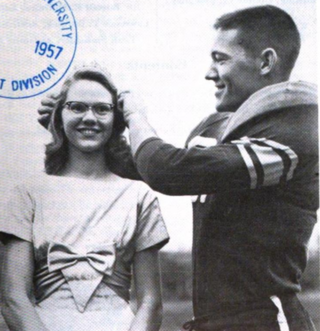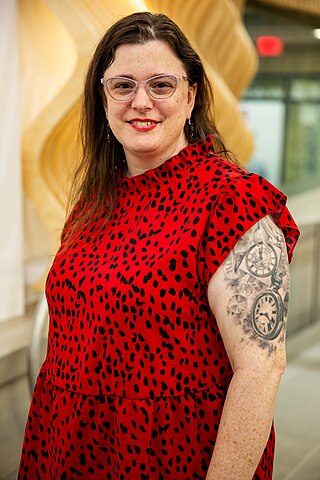
Gallaudet University is a private federally chartered university in Washington, D.C., for the education of the deaf and hard of hearing. It was founded in 1864 as a grammar school for both deaf and blind children. It was the first school for the advanced education of the deaf and hard of hearing in the world and remains the only higher education institution in which all programs and services are specifically designed to accommodate deaf and hard of hearing students. Hearing students are admitted to the graduate school and a small number are also admitted as undergraduates each year. The university was named after Thomas Hopkins Gallaudet, a notable figure in the advancement of deaf education.
Linda Bove Waterstreet is a Deaf American actress, her most notable role being a fictionalized version of herself in the PBS children's series Sesame Street from 1971 to 2002. Bove was the first Deaf actress to be a member of the program's recurring cast.

Deaf culture is the set of social beliefs, behaviors, art, literary traditions, history, values, and shared institutions of communities that are influenced by deafness and which use sign languages as the main means of communication. When used as a cultural label especially within the culture, the word deaf is often written with a capital D and referred to as "big D Deaf" in speech and sign. When used as a label for the audiological condition, it is written with a lower case d. Carl G. Croneberg coined the term "Deaf Culture" and he was the first to discuss analogies between Deaf and hearing cultures in his appendices C/D of the 1965 Dictionary of American Sign Language.

Deaf President Now (DPN) was a student protest in March 1988 at Gallaudet University, Washington, D.C. The protest began on March 6, 1988, when the Board of Trustees announced its decision to appoint a hearing candidate, Elizabeth Zinser, over the other Deaf candidates, Irving King Jordan and Harvey Corson, as its seventh president.
The National Theatre of the Deaf (NTD) is a Connecticut based theatre company founded in 1967, It is the oldest theatre company in the United States with a continuous history of domestic and international touring, as well as producing original works. NTD productions combine American Sign Language with spoken language to fulfill the theatre's mission statement of linking Deaf and hearing communities, providing more exposure to sign language, and educating the public about Deaf art. The NTD is affiliated with a drama school, also founded in 1967, and with the Little Theatre of the Deaf (LTD), established in 1968 to produce shows for a younger audience.

The California School for the Deaf is a school for deaf children in Fremont, California. The school educates deaf children from all over Northern California. Its campus in Fremont is adjacent to the campus of the California School for the Blind.

Andrew Jackson Foster (1925–1987) was an American pioneer of deaf education in several countries in Africa. In 1954, he became the first Deaf African American to earn a bachelor's degree from Gallaudet University, the American university for the Deaf, and the first to earn a master's degree from Eastern Michigan University. He earned a second master's degree from Seattle Pacific Christian College, also in education. He founded Christian Mission for the Deaf African in 1956 and set out for Accra, Ghana, where he established the first school for the deaf in West Africa.

The Nebraska School for the Deaf, or NSD, was a residential school for Deaf students in kindergarten through Grade Twelve at 3223 North 45th Street in Omaha, Nebraska, United States. Founded in 1869, the school closed in 1998. The school attracted national attention throughout its existence, first for controversial teaching practices and then for its closure.

George William Veditz was an American educator, filmmaker, and activist who served as the seventh President of the National Association of the Deaf from 1904 to 1910. He is remembered as one of the most ardent and visible advocates of American Sign Language (ASL) and was one of the first people to film ASL. His 1913 film "Preservation of the Sign Language" was added to the National Film Registry in 2010.

Olof Hanson was a deaf Swedish architect.

Edson Fessenden Gallaudet was a pioneer in the field of aviation. He was best known for his development of practical airfoils and aircraft propulsion systems for use in early seaplanes.
Chuck Baird was an American Deaf artist who was one of the more notable founders of the De'VIA art movement, an aesthetic of Deaf Culture in which visual art conveys a Deaf world view. His career spanned over 35 years and included painting, sculpting, acting, storytelling, and teaching.

Robert F. Panara was a poet, a professor and a co-founder of the National Technical Institute for the Deaf (NTID) and the National Theater of the Deaf. Panara is considered to be a pioneer in deaf culture studies in the United States.
Patsy Lynch is an American photographer. Her work documents GLBT civil rights advocacy.
Regina Olson Hughes (1895–1993) was an American scientific illustrator in Botanical Art. Born February 1, 1895, in Herman, Nebraska, she became fascinated with the world of plants and flowers. Her parents were Gilbert and Johanna (Sullivan) Olson. At age 10, she contracted scarlet fever and her hearing slowly diminished until she became fully deaf at age 14. In order for her to communicate with her peers, she relied on lip reading and written notes for business work. Hughes retained her speech skills and continued to speak fluently throughout her adulthood. She became proficient in American Sign Language when she enrolled in Gallaudet University.
Bruce Michael Mackintosh Hlibok was an American deaf actor.
Kendall Demonstration Elementary School (KDES) is a private day school serving deaf and hard of hearing students from birth through grade 8 on the campus of Gallaudet University in the Trinidad neighborhood of Washington, D.C. Alongside Model Secondary School for the Deaf, it is a federally funded, tuition-free demonstration school administered by the Laurent Clerc National Deaf Education Center at Gallaudet University.
Agatha Tiegel Hanson was the second woman to graduate from the National Deaf-Mute College in 1893 and the first woman to receive a Bachelor of Arts from the school. She worked as an educator for deaf students and advocated for the deaf community throughout her life. Hanson also wrote poetry and edited a newspaper for the deaf.

Jack Randle Gannon was an American author and historian of Deaf culture. Deaf since age eight, he had chronicled the history and culture of Deaf people and organizations around the world, most notably in his 1981 book Deaf Heritage. Gannon was an educator at the Nebraska School for the Deaf and served for many years in administrative roles at Gallaudet University.

Meredith Peruzzi is an American historian and Director of the National Deaf Life Museum (NDLM) in Washington D. C.














